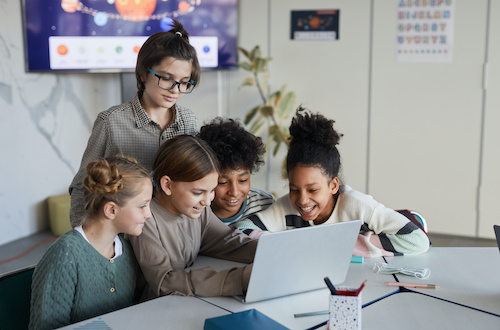Key points:
- An inclusive learning culture support high-quality SEL instruction
- UDL makes learning accessible for all students, leading to impactful SEL
- See related article: 5 to thrive: SEL resources to help students grow
Social and emotional learning (SEL) is a critical component of education today, and that’s especially true in the wake of the global pandemic, which has left many students grappling with anxiety, depression, and other social-emotional challenges. While high-quality SEL involves many elements, at its foundation is the need to establish a welcoming and inclusive learning environment for every student.
SEL is the process by which students learn the skills they need to understand and manage their emotions, set and achieve positive goals, feel and show empathy for others, establish and maintain positive relationships, and make responsible decisions. These skills are essential for navigating both academic and non-academic environments successfully, and they’re critical for improving behaviors, attitudes, and educational outcomes.
For SEL instruction to be effective, however, educators must create a welcoming and inclusive learning culture for everyone. As the Global Citizenship Foundation notes: “Fostering welcoming communities, promoting equity and equality, combating discrimination, and developing respect for others are all objectives aligned with SEL.”
It’s not realistic to ask students to develop an understanding of and empathy for diverse people and perspectives if their own needs and perspectives aren’t valued and supported within the classroom environment. Educators must practice and model these ideals for themselves if they expect students to acquire them—and this starts with designing inclusive learning environments in which everyone feels welcome and empowered to reach their full potential.
The Collaborative for Academic, Social, and Emotional Learning (CASEL), the leading authority on SEL instruction, recognizes the importance of inclusive learning environments in teaching SEL. The organization includes “welcoming inclusion activities” in its “3 Signature Practices Playbook,” a guide to implementing systemic SEL instruction in schools.
Aside from CASEL’s advice, here are three other important ways that educators can create learning environments that are welcoming and inclusive of all students.
Implement culturally responsive teaching practices.
Culturally responsive teaching integrates students’ cultures and life experiences into the learning process, such as by choosing culturally diverse teaching materials that reflect a wide variety of perspectives. This practice helps students feel seen and valued as members of the learning community.
Research shows that when students see themselves represented in the classroom, they’re more likely to engage in learning. When students feel like they belong, they become more deeply connected to school and more motivated to succeed. Culturally responsive teaching not only creates a sense of inclusion that leads to deeper engagement; it also helps students connect what they’re learning to their own lives—a strategy that makes learning experiences more personally relevant and meaningful.
Incorporate UDL into the learning design process.
A key way we make learning more inclusive for students at my school is by incorporating the Universal Design for Learning (UDL) Guidelines into instruction. UDL is an accessibility framework from CAST, the Center for Applied Special Technology, that helps educators develop flexible and inclusive learning environments that can accommodate students’ individual differences and learning preferences.
The UDL Guidelines call for giving students multiple ways to learn content, engage with course materials, and demonstrate their understanding. This allows all students to leverage their unique strengths and skills during the learning process.
Build accessibility into every learning experience.
For every learning activity we design, we ask ourselves: Is this accessible for every student? If not, can we build in modifications so that all students can participate equally?
The learning management system we’ve chosen for our courses, Brightspace by D2L, was created with full accessibility in mind. For example, it includes a tool that generates transcripts of online videos automatically. Many other popular LMS platforms still don’t do this today.
What’s more, we’ve embedded a text-to-speech software program called ReadSpeaker within our LMS. As students access course materials and other resources online, there is a prompt within the margin of the LMS that says: “Listen to this page using ReadSpeaker.” When students click on the “listen” button, they can hear the text read aloud, regardless of its source.
The software reads the characters and then converts the text into an audio file that sounds like a human talking. Students can listen to any text on the page, and they can speed up or slow down the audio as needed. They can enlarge the text, choose from a menu of different voices, or have the text translated for them. They can even download the audio file so they can listen to it on their phone like they would do with a podcast.
By ensuring that all students feel welcome and supported on their educational journey, educators are establishing the foundation upon which successful SEL instruction relies. When students feel valued and included for themselves, they’re much more likely to embrace the message of empathy and respect for others.
Related:
5 essential SEL reads
Advocating for student mental health starts here
- 4 ways to encourage play in education - April 25, 2024
- CoSN IT Leader Spotlight: Lisa Higgins - April 25, 2024
- It’s time to pay student teachers - April 25, 2024

